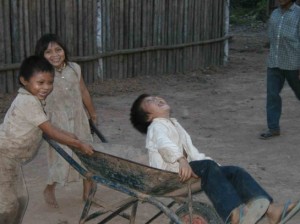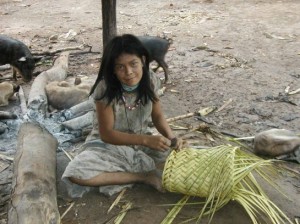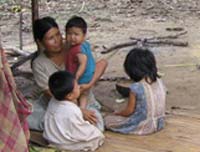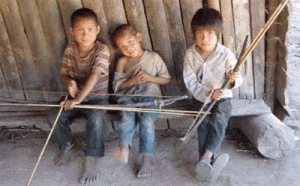 |
How important is traditional plant knowledge in the Amazon? According to a recent study among the Tsimane’ in Amazonian Bolivia, each standard deviation of maternal ethnobotanical knowledge increases the likelihood of good child health by more than fifty percent. And the study raises the question: What will be the cost — to the Tsimane’ and other indigenous peoples — if such ethnobotanical knowledge is lost?
The Tsimane’ number about 8,000 people who live in about 100 villages along the Maniqui River and the interior of the Pilon Lajas region of the Bolivian Amazon. Tsimane’ villages are small, with an average of about 24 households linked by kinship and marriage. At the time of the study, no household had electricity or running water, and half the villages were inaccessible by road. The Tsimane’ have traditionally lived by slash-and-burn agriculture, gathering, hunting, and fishing. However, since the 1970s, their territory has been encroached on by colonist farmers, logging firms, cattle ranchers, and oil companies. The Tsimane’ now increasingly interact with the market economy through the sale of goods and wage labor, primarily on cattle ranches, logging camps, and farms.
 |
Such integration into the market economy brings about changes in occupation, preferences, social organization, and health and nutritional status. The Tsimane’ are now starting to merge into a culture that places no value on their indigenous knowledge, especially their ethnobotanical knowledge. Under this pressure, traditional knowledge of medicinal plants is starting to disappear, with little to take its place. Too often, as here, the global market holds out the offer of western medicine without providing the means to gain access to it.
 |
Thomas McDade and William Leonard from Northwestern University set out to learn what impact the loss of traditional plant knowledge might have on the health of children. To do this, they assessed the health of 330 Tsimane’ children, aged from two to ten years old, and tested their mothers and fathers on both their knowledge of local plants and their skills at using them. Local ethnobotanical knowledge was quantified using five measures — agreement with local experts on plant uses; botanical knowledge; skills in using plants; total number of plants used; and diversity of plants used. Child health was measured using three variables — concentration of C-reactive protein, a marker of infectious burden; skinfold thickness, a measure of fat stores; and stature, used to calculate height-for-age scores, an indicator of nutritional and health status.
The results were striking. For each measure of health, mothers with higher levels of plant knowledge and use had healthier children, independent of potentially confounding variables related to education, market participation, and acculturation. The Tsimane’ ethnomedical tradition
may play a particularly important part in protecting health because effective commercial medicines are expensive and difficult for the Tsimane’ to procure. If remedies derived from local plants are effective in preventing or treating illness, this would contribute not only to lower levels of inflammation but also to improved linear growth and body fat stores by reducing allocations of energy to fueling immunity and fighting infection.
 |
Strikingly, although the authors infer a direct association between maternal plant knowledge and child health, it may be that this association is mediated by the children themselves. Tsimane’ children spend much of their time away from parental supervision, playing and foraging in small peer groups, and the authors report seeing older children use medicinal plants both for themselves and for younger children. It may be that plant knowledge — like so much other cultural knowledge — is passed, not from adults to children, but rather from older children to younger children.
In the preservation of plant knowledge lies the destiny of the people.

- Previous Post: Jungle Music
- Next Post: Weeds
- More Articles Related to: Indigenous Culture, Plant Medicine, Research Studies



Again, a comparative perspective: I have done a bit of research at a place in Bangalore, India, called the Foundation for the Revitalization of Local Health Traditions. See their absolutely phenomenal web site: frlht.org. They send anthropologists, medical and botanical researchers, and others out to the countryside all over India to gather plant lore from ordinary people, particularly targeting older women, who they believe (correctly) know more than others about this. This supplements the knowledge of the ancient medical texts. Such an initiative would not be a waste of time in such a rich ecological area as the Amazon basin.